Chrysler
was dominating with their Hemi powered lightweights, and they carried this
over into 1965 (see the A990 Hemi). The NHRA had a Factory Experimental
class with less restrictive rules, so Chrysler took the opportunity to build
a really outrageous factory race car. Unfortunately, the NHRA found these
cars to be unacceptable for this class, so the cars actually debuted in the AHRA in Phoenix, Arizona. They were an instant success with the fans!
(12)
factory A/FX cars were built; (6) Dodge and (6) Plymouth.
* Other
racers made an unknown number of copies.
Dodge
Bobby
Harrop, The Flying Carpet
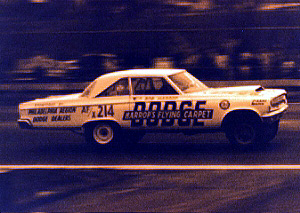
Bub
Faubel, Hemi Honker
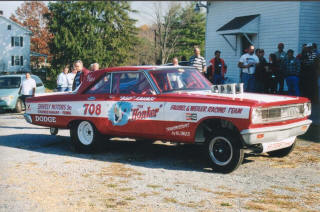
Dave
Strickler
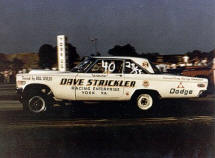
Dick
Landy
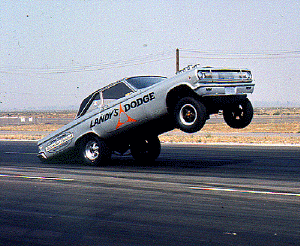
Jim
Thornton and Mike Buckel, Ramchargers
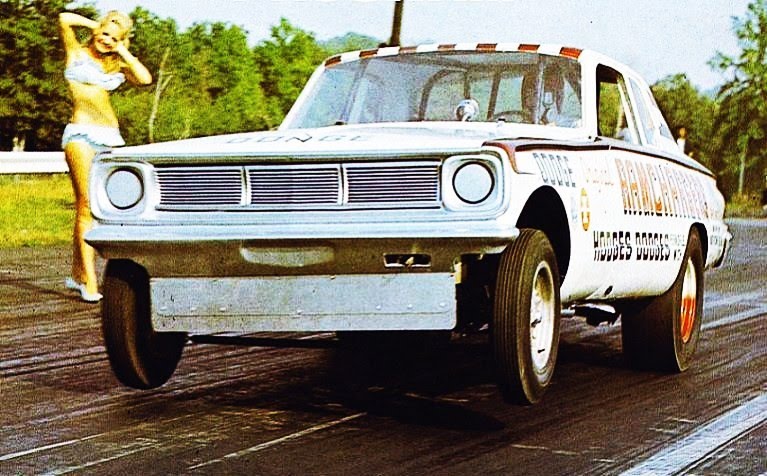
Roger
Lindamood, Color Me Gone
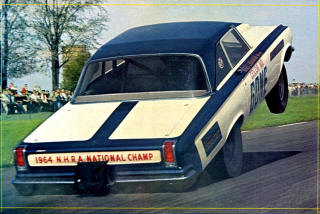
Plymouth
A/FX Test
Mule (for Plymouth)
Al
Eckstrang and Forest Pitcock, Colden Commando Club Car
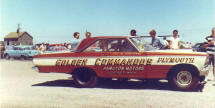
Butch
Leal, California Flash
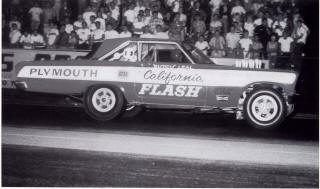
Lee Smith
Ronnie
Sox, Sox and Martin

Tom Grove
and Cecil Yother, Melrose Missile
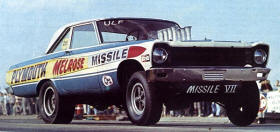
The
bare bodies were constructed at Chrysler's Los Angeles assembly plant, and
shipped to an outside vendor for acid dripping. This process allowed the
body weight to be reduced by 200 pounds. The A/FX mods were pretty
extensive, so they could not be done on the regular assembly line. The
bodies were then shipped to Amblewagon -- a Troy, MI contractor
specializing in ambulance conversions.
Obviously the forward
relocation of the front and rear axles caused considerable sheet metal
work (unibody construction).
The
front wheels were moved forward by installing special lower sub frame
rails and sectioning the inner fender panels. The upper control arm pivot
and shock mount were moved 10" forward. A lightweight stainless steel
K-member also bolts on the new frame rails 10" farther forward. The
steering linkage was extended and longer torsion bars installed to
compensate for the relocation.
To move
the rear axle forward, the floor pan was sectioned and a 15" section
removed. The floor pan "kick pan" was moved forward to the area formerly
housing the rear seat. The quarter panels were sectioned and the stock
wheel openings moved forward the appropriate amount. Sheet metal filler
panels were added to the sectioned areas and everything was welded back
together. A cross braced four point roll bar was installed for chassis
stiffening.
Finally,
fiberglass doors on lightweight hinges were added to the already light
body. A fiberglass deck lid with an OEM latch and fiberglass hood with a
slightly taller version of the A990 type scoop were installed. The fixed
windows were thin Chemcor Plexiglas. The front bumper was also fiberglass,
which molded in mounting brackets. The rear bumper remained steel to
maintain rear end weight.
Inside
the car was the roll cage, a fiberglass dashboard replica, lightweight
Bostrom bucket seats on aluminum mounts and carpeting. The radio, heater,
arm rests, sun visors, dome light, rear seat, carpet padding and sound
deadeners were all removed.
The cars
weighed 2800 pounds when delivered.
Weight
distribution was excellent, with 56% on the rear.
The
power for these A/FX cars was the same engine as the 1965 A990 Super
Stockers (the A990 426 Hemi). Actually, an actual A990 S/S car was
cannibalized for the engine, driveline and interior for each A/FX car. The
A990 426 Hemi cranked out over 500 horsepower.
During
the 1965 season, Chrysler engineered a fuel injection system using Hilborn
injectors with reworked mid-range and high-speed circuits. The velocity
stacks varied depending on the transmission type. 13-1/4" stacks on
TorqueFlite cars and 7-1/4" stacks on 4-speed cars. Performance was
increased with this system over the dual Holley carbs. High 9s at 140-mph
were not uncommon near the end of 1965
